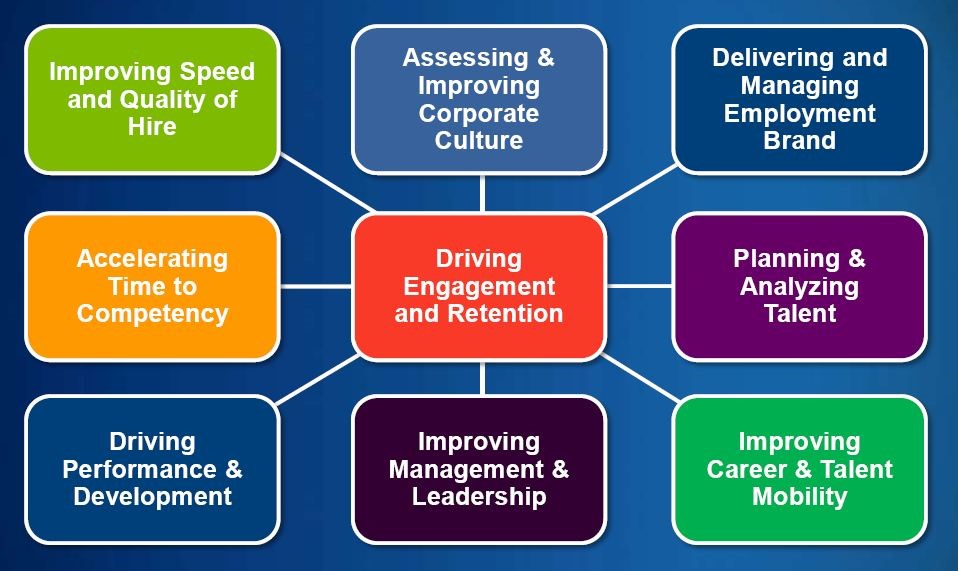Among the speakers at the HR Tech conference held recently in Las Vegas was Josh Bersin, a highly respected consultant and principal and founder of Bersin by Deloitte, Deloitte Consulting. “Talent Management? Isn’t that for Hollywood?” he asked. Here is some of Bersin’s research along with tips for succeeding with a talent agenda for the new year.
 |
Most of HR is designed for long-term employment, he says, but the recession coupled with the ages of employees lead to a much more mobile workforce, and that’s a really critical issue for 2015.
Here’s what Bersin’s research shows are the top talent priorities:
Top Global Talent Priorities
|
Priority |
Percent of respondents rating “Urgent” or “Important” |
|
Leadership Gaps |
89% |
|
Retention & Engagement |
78% |
|
Reskilling HR |
78% |
|
Talent Acquisition & Access |
75% |
|
Workforce Capabilities |
75% |
|
Talent & HR Analytics |
74% |
|
Globalized HR & Talent Management |
71% |
|
Integrated HR Technology |
70% |
|
Reinvent L&D |
69% |
|
Fix Performance Management |
67% |
|
The Overwhelmed Employee |
62% |
|
Diversity & Inclusion |
60% |
We used to look at these priorities as separate silos, says Bersin:
- Learning and Development
- Sourcing and Recruiting
- Performance Management
- Leadership Development
- Succession Planning
- Workforce Planning
- Compensation and Benefits
We realized that an integrated approach was needed, says Bersin, but the old idea of integrated talent management didn’t work for four main reasons:
- Slow Response to Changing Business Needs
- Inability to identify current and future talent gaps
- Hiring strategy and development planning not in sync
- No clear picture of future “talent profile”
- Leadership pipelines in jeopardy
- Disconnected Decision Making
- Data and processes not integrated
- Talent not shared across business units
- Learning plans not linked to assessments and skills gaps in current talent pool
- Lack of visibility into talent gaps
- Not Responsive to Employee Demands
- Employees want career development
- Defined career paths and competencies not clear and consistent
- Talent mobility difficult during change
- Managers still the weakest link in organizational performance
- Administratively Intensive
- Data entry is repetitive
- High volume of manual work to complete HR review processes
- Difficult to obtain executive-level talent information
- Hard to plan for the future
Try BLR’s all-in-one compensation website, Compensation.BLR.com®, and get a complimentary special report, Top 100 FLSA Overtime Q&As, no matter what you decide. Find out more.
Today, everything touches everything. We need a holistic view, says Bersin, who offers this chart to help HR managers envision this new approach. If you have the right people and you master the central point—driving engagement and retention—your problems go away, he says.
 Copyright 2014 Deloitte Development LLC
Copyright 2014 Deloitte Development LLC
Top Practices in Talent Acquisition
Talent acquisition is the most important challenge of all, says Bersin. He offers the following 12 practices that will lead to success in talent acquisition:
- Hiring Manager Relationships
- Candidate Pool Development
- Social Media Campaign
- Recruiter Training
- Governance & Decision Making
- Employee Referral Program
- TA Program Management
- Optimized TA Technology
- Diverse Candidate Slates
- Employment Branding
- Assessment Against Requirements
- Reporting & Analytics
Try BLR’s all-in-one compensation website, Compensation.BLR.com®, and get a complimentary special report, Top 100 FLSA Overtime Q&As, no matter what you decide. Find out more.
Talent Acquisition Maturity Model
Bersin’s model posits four levels of talent acquisition maturity, with Level 4 being the most advanced:
|
Level |
Description |
% at that level |
|
Level 4 |
Optimized Talent Acquisition |
13 % |
|
Level 3 |
Integrated Talent Acquisition |
23% |
|
Level 2 |
Standardized Operational Recruiting |
29% |
|
Level 1 |
Reactive Tactical Recruiting |
35% |
What Difference Does It Make?
Bersin’s research found that Level 4 organizations are 2.6 times more likely to perform higher than organizations at Level 1 across all talent acquisition performance drivers.
The top three drivers of talent acquisition maturity are:
- Building strong relationships with hiring managers. You have to coach your line managers and give them tools.
- Cultivating pools of potential candidates long before hire. “Bring them into your ecosphere,” Bersin says, as Zappos is famously doing now.
- Driving the employment brand.
In tomorrow’s Advisor, more from Bersin, plus an introduction to the all-things-compensation-in-one-place website, Compensation.BLR.com®.

I’d say retention is equally important to acquisition, if not more so.